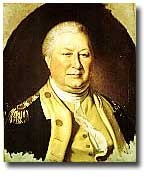History

Created in 1957, Smallwood State Park takes its name from General William Smallwood, a major general who served in the Continental Army during the American War of Independence and, later, served as the 4th Governor of Maryland. His restored plantation house, called Smallwood's “Retreat,” is located on park grounds.
The Life of General Smallwood
One of seven children, William Smallwood was born in 1732. Little is known about his upbringing. His family were members of the emerging colonial-tidewater aristocracy and active in politics. Bayne Smallwood, his father, served as a delegate to the Maryland Assembly, was a justice of county court, and served as a lieutenant colonel in the local militia. In private life Bayne Smallwood was a merchant and tobacco planter. He owned a large tract of land on the Potomac River in Charles County called Mattawoman Plantation.
William Smallwood’s public career began in 1761 when he was elected to the Maryland Assembly. During the decade-and-a-half that he sat in the Assembly, Smallwood gained a reputation for decisive leadership while serving on several influential and important committees. As tensions between the American colonies and Great Britain increased, Smallwood consistently and strongly opposed British policies.
Upon the outbreak of hostilities between the American colonists and Great Britain in 1775, Smallwood took command of the first full-strength Maryland battalion to join the
Continental Army. Smallwood's battalion played a key role in the Battle of Long Island on August 26, 1776 and in the Battle of White Plains in October of the same year. Smallwood was promoted to Brigadier General after being wounded at White Plains. Later in the war, Smallwood and his troops helped hold the American armies together after a major defeat at the Battle of Camden, in South Carolina, in August 1780. Smallwood was also promoted to Major General, the highest rank attained by a Marylander in Continental service.
Following the war, Smallwood returned to his Charles County plantation. In 1785 the state legislature elected him governor. He served in that office until 1788 and played an important role in Maryland's ratification of the Federal Constitution. In 1791 Smallwood was elected to the State Senate and served as the chamber’s presiding officer.
Smallwood was a founder and first president of the Maryland chapter of the Sons of the Cincinnati, an organization of regular officer veterans. He was also a member of the Alexandria, Virginia Masonic Lodge, and was active in the affairs of Durham Parish Episcopal Church.
Smallwood died in 1792. A memorial to his service stands on the slope below his house.
Smallwood’s Plantation
William Smallwood’s life coincided with the emergence of the colonial-tidewater aristocracy, whereby wealth and influence were attained by enslaved African-American laborers raising tobacco on large plantations. Smallwood’s “Retreat” house, built in approximately 1760, with its early Federalist-style architectural features, illustrates tidewater aristocracy’s ascendance.
By 1790, Smallwood possessed 56 enslaved people. Little is known about the enslaved laborers at “Retreat,” but it is likely that most lived in separate quarters elsewhere on the property. No structures associated with the property’s enslaved workforce survive. Most enslaved laborers served as field hands, but others were skilled in blacksmithing and carpentry. These workers were indispensable to the operations of the plantation, however they likely worked and lived in harsh conditions. They could be sold at their owner’s whim, and were typically required to perform hard labor from sunrise-to-sunset, especially during the hottest months of the year.
At peak production, Smallwood likely cultivated about 120 acres of tobacco annually. The remainder of the property was used to grow food such as barley, oats, corn and wheat, plus raise livestock in order to feed his family and workforce. Many enslaved
laborers likely maintained vegetable gardens.
Smallwood State Park
William Smallwood never married and died without heirs. His house was primarily occupied by tenant farmers in the 19th century before being abandoned and falling into disrepair. In the 1930s, a group of concerned citizens formed the Smallwood Foundation to acquire and restore the historic house. In 1958, one year after the Smallwood State Park was formally created, the Foundation donated the restored and refurnished house and surrounding ten acres to the park.
Smallwood’s “Retreat” house and the nearby Jenkins Tobacco Barn illustrate the gap between those who owned or worked the land. The restored and furnished home reflects the lifestyle of an 18th century tidewater gentleman. The circa-1825 tobacco barn, relocated to the park in the 1980s from a nearby county-owned site, interprets the important role tobacco culture played in the history of southern Maryland.